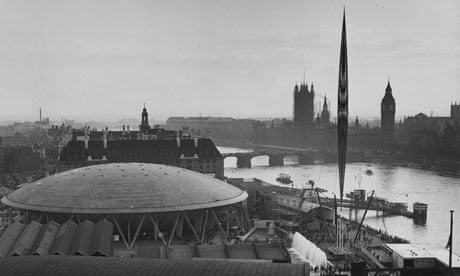The Skylon, the slender steel tower that formed the centre of the Festival of Britain, had no visible means of support. Neither did the British economy, or so the joke went in 1951. Sixty years later, that seems far more true than it was then, with the economy staked on two radically invisible economic confidence tricks: the property market, where mundane housing becomes magical investments; and the immaterial, money-generating-money world of "financial services". Both are hugely destructive but both, seemingly, politically impregnable, no matter how much damage they cause. So it's ironic that a campaign to re-erect the Skylon lumbers on, and will be given extra impetus this summer by a strange Festival of Britain Festival on its former site, London's South Bank.
The Festival of Britain was a "tonic for the nation" in the last age of austerity, a series of events in London (with a touring exhibition), intended to usher in a new world of modernity and abundance – often with a socialist slant. The Skylon and its demolished nearby structures – the Dome of Discovery, Sea and Ships, Power and Production or the Telekinema – or the Royal Festival Hall, the survivor, symbolised the embattled optimism of the postwar Labour government; a road not travelled politically as much as architecturally. Its buildings, influenced by Swedish Modernism, imagined Britain as a northern European social democratic country, not a mid-Atlantic one. A place comfortable with modern architecture, modernity and material production, rather than the Americanised, deindustrialised mess we put up with. It was as much a monument of the era as the NHS, universal benefits or nationalised industries, and faced a similar fate.
It is ironic that the festival is being revived under the coalition, as the original buildings – save for the more permanent Festival Hall – were wantonly smashed when the Tories miraculously won the 1951 election, despite Labour winning a still unprecedented 49% of the popular vote. Churchill called it "three-dimensional socialist propaganda" – and it was. Yet there's a deeper reason for the two to coincide.
In their rhetoric of belt-tightening, in the ludicrous notion that "we're all in this together", the millionaires' austerity government is tapping into something that predates it, but which accompanied the start of the financial crisis in 2008. Since then, an austerity nostalgia has been rife among the middle class: in the wartime aesthetics of Jamie Oliver's Ministry of Food; in retro-modernist CCTV posters; most of all in the phenomenal success of the Keep Calm and Carry On poster. At the Festival Hall's shop, it can sometimes seem like you're in a 1940s theme park, with all manner of austere rationing-era ephemera for sale. It hinges on the somewhat gross analogy between our predicament and the blitz, or the rationing that lasted well into the 50s – the "blitz spirit" attendant on every transport disruption or tube strike. Cameron's government has consciously appealed to this trend.
By contrast with the original festival's socialist optimism, the new festival – sponsored by Mastercard – will feature a show by Tracey Emin, who threatened to emigrate in response to Labour's mild income tax rise. Similarly, our new austerity is based on destroying the things the earlier austerity had created – the NHS, free education, non-means-tested benefits, council housing. The latter, now an emergency refuge, was an intrinsic part of the Festival.
A few miles east of the main site was the festival's Living Architecture Exhibition, an estate of mildly modernist terraces and low-rise flats in Poplar, an example of the new Britain which Labour aimed to create. By contrast, neither the coalition nor the South Bank organisers seem to have any notion of a viable future. The new festival – especially if it gives in and rebuilds the Skylon – will be an exercise in nostalgia, in morbid and wildly inaccurate historical analogy, at a time when we desperately need an infusion of the original festival's socialist, futuristic spirit.
